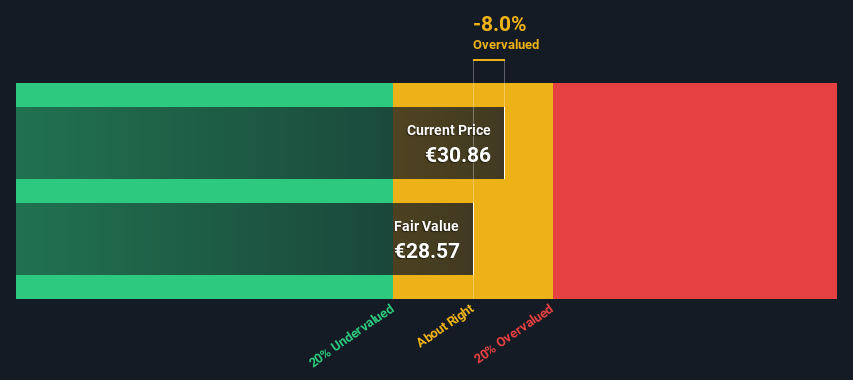- Finland
- /
- Paper and Forestry Products
- /
- HLSE:UPM
Estimating The Intrinsic Value Of UPM-Kymmene Oyj (HEL:UPM)

Key Insights
- UPM-Kymmene Oyj's estimated fair value is €28.57 based on 2 Stage Free Cash Flow to Equity
- With €30.86 share price, UPM-Kymmene Oyj appears to be trading close to its estimated fair value
- Analyst price target for UPM is €37.32, which is 31% above our fair value estimate
In this article we are going to estimate the intrinsic value of UPM-Kymmene Oyj (HEL:UPM) by estimating the company's future cash flows and discounting them to their present value. We will use the Discounted Cash Flow (DCF) model on this occasion. Before you think you won't be able to understand it, just read on! It's actually much less complex than you'd imagine.
We would caution that there are many ways of valuing a company and, like the DCF, each technique has advantages and disadvantages in certain scenarios. If you want to learn more about discounted cash flow, the rationale behind this calculation can be read in detail in the Simply Wall St analysis model.
Check out our latest analysis for UPM-Kymmene Oyj
What's The Estimated Valuation?
We use what is known as a 2-stage model, which simply means we have two different periods of growth rates for the company's cash flows. Generally the first stage is higher growth, and the second stage is a lower growth phase. In the first stage we need to estimate the cash flows to the business over the next ten years. Where possible we use analyst estimates, but when these aren't available we extrapolate the previous free cash flow (FCF) from the last estimate or reported value. We assume companies with shrinking free cash flow will slow their rate of shrinkage, and that companies with growing free cash flow will see their growth rate slow, over this period. We do this to reflect that growth tends to slow more in the early years than it does in later years.
A DCF is all about the idea that a dollar in the future is less valuable than a dollar today, and so the sum of these future cash flows is then discounted to today's value:
10-year free cash flow (FCF) estimate
| 2023 | 2024 | 2025 | 2026 | 2027 | 2028 | 2029 | 2030 | 2031 | 2032 | |
| Levered FCF (€, Millions) | €1.58b | €1.82b | €1.71b | €1.54b | €1.67b | €1.62b | €1.60b | €1.58b | €1.57b | €1.57b |
| Growth Rate Estimate Source | Analyst x6 | Analyst x7 | Analyst x6 | Analyst x3 | Analyst x3 | Est @ -2.53% | Est @ -1.64% | Est @ -1.02% | Est @ -0.58% | Est @ -0.27% |
| Present Value (€, Millions) Discounted @ 11% | €1.4k | €1.5k | €1.3k | €1.0k | €1k | €880 | €781 | €698 | €627 | €564 |
("Est" = FCF growth rate estimated by Simply Wall St)
Present Value of 10-year Cash Flow (PVCF) = €9.7b
We now need to calculate the Terminal Value, which accounts for all the future cash flows after this ten year period. For a number of reasons a very conservative growth rate is used that cannot exceed that of a country's GDP growth. In this case we have used the 5-year average of the 10-year government bond yield (0.4%) to estimate future growth. In the same way as with the 10-year 'growth' period, we discount future cash flows to today's value, using a cost of equity of 11%.
Terminal Value (TV)= FCF2032 × (1 + g) ÷ (r – g) = €1.6b× (1 + 0.4%) ÷ (11%– 0.4%) = €15b
Present Value of Terminal Value (PVTV)= TV / (1 + r)10= €15b÷ ( 1 + 11%)10= €5.5b
The total value is the sum of cash flows for the next ten years plus the discounted terminal value, which results in the Total Equity Value, which in this case is €15b. The last step is to then divide the equity value by the number of shares outstanding. Compared to the current share price of €30.9, the company appears around fair value at the time of writing. Valuations are imprecise instruments though, rather like a telescope - move a few degrees and end up in a different galaxy. Do keep this in mind.

The Assumptions
The calculation above is very dependent on two assumptions. The first is the discount rate and the other is the cash flows. If you don't agree with these result, have a go at the calculation yourself and play with the assumptions. The DCF also does not consider the possible cyclicality of an industry, or a company's future capital requirements, so it does not give a full picture of a company's potential performance. Given that we are looking at UPM-Kymmene Oyj as potential shareholders, the cost of equity is used as the discount rate, rather than the cost of capital (or weighted average cost of capital, WACC) which accounts for debt. In this calculation we've used 11%, which is based on a levered beta of 1.556. Beta is a measure of a stock's volatility, compared to the market as a whole. We get our beta from the industry average beta of globally comparable companies, with an imposed limit between 0.8 and 2.0, which is a reasonable range for a stable business.
SWOT Analysis for UPM-Kymmene Oyj
- Earnings growth over the past year exceeded its 5-year average.
- Debt is well covered by earnings.
- Earnings growth over the past year underperformed the Forestry industry.
- Dividend is low compared to the top 25% of dividend payers in the Forestry market.
- Expensive based on P/E ratio and estimated fair value.
- Annual revenue is forecast to grow faster than the Finnish market.
- Debt is not well covered by operating cash flow.
- Paying a dividend but company has no free cash flows.
- Annual earnings are forecast to grow slower than the Finnish market.
Next Steps:
Whilst important, the DCF calculation shouldn't be the only metric you look at when researching a company. It's not possible to obtain a foolproof valuation with a DCF model. Rather it should be seen as a guide to "what assumptions need to be true for this stock to be under/overvalued?" For instance, if the terminal value growth rate is adjusted slightly, it can dramatically alter the overall result. For UPM-Kymmene Oyj, we've compiled three important elements you should consider:
- Risks: We feel that you should assess the 1 warning sign for UPM-Kymmene Oyj we've flagged before making an investment in the company.
- Future Earnings: How does UPM's growth rate compare to its peers and the wider market? Dig deeper into the analyst consensus number for the upcoming years by interacting with our free analyst growth expectation chart.
- Other High Quality Alternatives: Do you like a good all-rounder? Explore our interactive list of high quality stocks to get an idea of what else is out there you may be missing!
PS. The Simply Wall St app conducts a discounted cash flow valuation for every stock on the HLSE every day. If you want to find the calculation for other stocks just search here.
New: AI Stock Screener & Alerts
Our new AI Stock Screener scans the market every day to uncover opportunities.
• Dividend Powerhouses (3%+ Yield)
• Undervalued Small Caps with Insider Buying
• High growth Tech and AI Companies
Or build your own from over 50 metrics.
Have feedback on this article? Concerned about the content? Get in touch with us directly. Alternatively, email editorial-team (at) simplywallst.com.
This article by Simply Wall St is general in nature. We provide commentary based on historical data and analyst forecasts only using an unbiased methodology and our articles are not intended to be financial advice. It does not constitute a recommendation to buy or sell any stock, and does not take account of your objectives, or your financial situation. We aim to bring you long-term focused analysis driven by fundamental data. Note that our analysis may not factor in the latest price-sensitive company announcements or qualitative material. Simply Wall St has no position in any stocks mentioned.
About HLSE:UPM
UPM-Kymmene Oyj
Engages in the forest-based bioindustry in Europe, North America, Asia, and internationally.
Adequate balance sheet average dividend payer.
Similar Companies
Market Insights
Community Narratives



